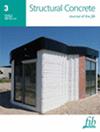利用三维刚体弹簧模型,通过内应力和裂纹发展研究 ASR 损坏的 RC 梁的抗弯行为
IF 3.3
3区 工程技术
Q2 CONSTRUCTION & BUILDING TECHNOLOGY
引用次数: 0
摘要
碱硅反应(ASR)是影响混凝土结构安全的耐久性问题之一。数值模拟有助于监测存在 ASR 损伤的钢筋混凝土(RC)结构的内部状况,并预测其长期行为。由于离散模拟方法适用于混凝土出现与膨胀和开裂相关的耐久性问题的情况,因此我们进一步开发了一种称为三维刚体弹簧模型(3D RBSM)的中尺度离散分析方法,该方法已用于模拟材料尺度上的混凝土 ASR 损伤,以模拟结构尺度上的 ASR 损伤。在这次开发中,骨料没有单独建模,而是加入了膨胀元素来模拟 ASR 的膨胀,从而允许更大的元素尺寸(1-2 厘米)。元素数量和计算时间减少到 1%以下。该建议模型用于模拟 RC 梁的 ASR 损伤和梁的残余抗弯能力。通过模拟可以直观地看到内部应力和开裂情况,从而解释了 RC 梁的承载能力不受 ASR 损伤影响的原因:首先,由于箍筋的约束作用,梁截面的核心部分几乎没有裂缝形成,因此 ASR 损伤后横截面的有效深度得以保持;其次,虽然存在 ASR 损伤,但受拉钢筋已经屈服。此外,剪切裂缝的发展受到抑制也可能是实验和模拟中受损 RC 梁的抗弯能力略有提高的原因之一。本文章由计算机程序翻译,如有差异,请以英文原文为准。
Investigating the flexural behavior of ASR‐damaged RC beam through internal stress and cracking development using 3D Rigid Body Spring Model
The alkali‐silica reaction (ASR) is one of the durability issues that affect the safety of concrete structures. Numerical simulation is useful for monitoring the internal condition of a reinforced concrete (RC) structure with ASR damage and predicting its long‐term behavior. Since discrete methods of simulation suit situations where concrete undergoes durability issues associated with expansion and cracking, a mesoscale discrete analysis method known as the three‐dimensional Rigid Body Spring Model (3D RBSM), as already used to simulate concrete ASR damage at the material scale, has been further developed to simulate ASR damage at the structural scale. In this development, the aggregate is not separately modeled and expansive elements are included to simulate ASR expansion, allowing a larger element size (1–2 cm). The number of elements and computation time are reduced to less than 1%. This proposed model is used to simulate ASR damage in a RC beam and the beam's residual flexural capacity. The simulation allows the internal stress and cracking condition to be visualized, leading to an explanation as to why the loading capacity of a RC beam is not affected by ASR damage: first, almost no cracks form at the core of the beam section due to the stirrup confinement, so the effective depth of the cross section is maintained after ASR damage; second, the tensile reinforcements have already yielded although ASR damage exists. Besides, the inhibited development of shear cracks may be one of the reasons for the slight improvement of flexural capacity of the damaged‐RC beam in experiment and simulation.
求助全文
通过发布文献求助,成功后即可免费获取论文全文。
去求助
来源期刊

Structural Concrete
CONSTRUCTION & BUILDING TECHNOLOGY-ENGINEERING, CIVIL
CiteScore
5.60
自引率
15.60%
发文量
284
审稿时长
3 months
期刊介绍:
Structural Concrete, the official journal of the fib, provides conceptual and procedural guidance in the field of concrete construction, and features peer-reviewed papers, keynote research and industry news covering all aspects of the design, construction, performance in service and demolition of concrete structures.
Main topics:
design, construction, performance in service, conservation (assessment, maintenance, strengthening) and demolition of concrete structures
research about the behaviour of concrete structures
development of design methods
fib Model Code
sustainability of concrete structures.
 求助内容:
求助内容: 应助结果提醒方式:
应助结果提醒方式:


